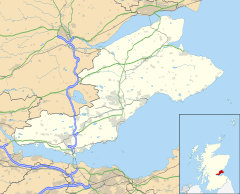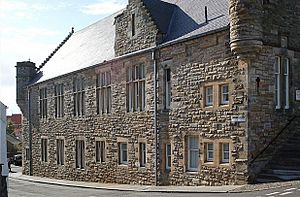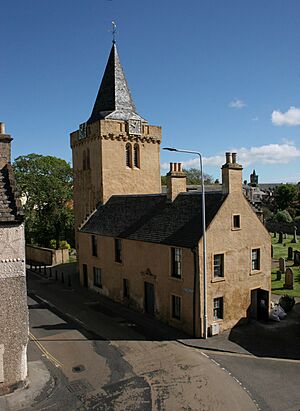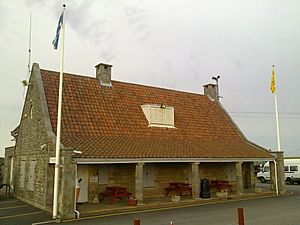Anstruther facts for kids
Quick facts for kids Anstruther
|
|
|---|---|
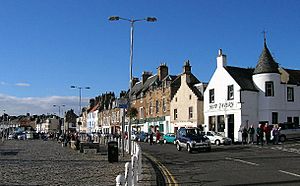 Anstruther seafront |
|
| Population | 3,950 (2020) |
| OS grid reference | NO564035 |
| Council area | |
| Lieutenancy area | |
| Country | Scotland |
| Sovereign state | United Kingdom |
| Post town | Anstruther |
| Postcode district | KY10 |
| Dialling code | 01333 |
| Police | Fife |
| Fire | Fife |
| Ambulance | Scottish |
| EU Parliament | Scotland |
| UK Parliament |
|
| Scottish Parliament | |
Anstruther (pronounced 'an-struh-ther') is a small town on the coast of Fife, Scotland. It's located on the northern shore of the Firth of Forth, about 9 miles (14 km) south-southeast of St Andrews. The town is actually made up of two older settlements: Anstruther Easter and Anstruther Wester. These two parts are separated by a small stream called the Dreel Burn. With about 3,500 people, Anstruther is the biggest community in this part of the coast, known as the East Neuk. To the east, it joins up with the village of Cellardyke.
Contents
What is Anstruther Like?
Anstruther started as a fishing village, and you can still see its history at the Scottish Fisheries Museum. Today, the harbour is mostly used by boats for fun, and there's a golf course nearby.
You can take boat trips from the harbour to the Isle of May. This island is famous for its many puffins, which are small, colourful seabirds. You can see them from April to October. The island is also home to lots of other wildlife, including seal colonies.
The Waid Academy is the local high school and an important part of the community. It also acts as a community centre. In the middle of Anstruther, there's a parish church on a small hill. It has a unique tower and spire, which is rare in Britain but common in this area.
Anstruther is well-known for its fish and chips shops. The Anstruther Fish Bar even won "Fish and Chip shop of the year" twice!
The town also has Scotland's only true-scale model of the Solar System. This model shows the Sun, planets, and the huge distances between them all at the same scale (1 to ten billion). It stretches almost 600 meters from the Sun to Pluto, mostly through the town centre.
Close to Anstruther, you can find the Caves of Caiplie along the coastal path towards Crail.
After the Cold War ended, one of Anstruther's biggest secrets became a popular place for visitors. A secret nuclear bunker was built here in 1951 and was used until 1993. It's located on the B940 road near the village. When it was active, it looked like a normal house. Now, it's a museum open to the public. This bunker was a backup government centre in case of a nuclear emergency. It would have been used by the armed forces and other government staff.
A bit outside the town centre, in Anstruther Wester, is the Dreel Tavern. This old building dates back to the 1600s. Nearby is Buckie House, built in the late 1600s. Its outside walls were decorated with scallop shells and whelks (called 'buckies') in the mid-1800s.
A Look Back in Time
The name Anstruther comes from an old Scottish language called Scottish Gaelic. The second part of the name, sruthair, means 'burn' or 'stream'. The first part might mean 'driving' or 'one', so the name could mean 'driving current' or 'place of one burn'. Anstruther Easter is called 'Easter' because it's to the east, and Anstruther Wester is 'Wester' because it's to the west. The two parts of the town are separated by the Dreel Burn stream.
Local stories say that in the early 1100s, Alexander I of Scotland gave the land of Anstruther to a person named William de Candela. However, the first official record of a lord of Anstruther is from 1225. The de Candela family actually came from England, probably from Normandy around 1066. Later, the family stopped using the de Candela name. In 1225, the Pope had to help settle a disagreement about fishing taxes between monks and Anstruther fishermen. This shows that fishing was already very important here!
In December 1583, James VI of Scotland made Anstruther a Royal Burgh. This gave the town special trading rights and showed how important its port was.
The diary of James Melville tells an interesting story about a ship from the Spanish Armada arriving in Anstruther. Local legends say that some of the Spanish sailors stayed and married people from the town.
By the 1800s, Anstruther-Easter, Anstruther-Wester, and Kilrenny were all separate royal towns with their own trading rights. Anstruther-Easter had businesses for making leather, building ships, and curing fish. In the 1870s, a new harbour was built, costing a lot of money at the time. By the First World War, trains connected the communities to St Andrews.
The Dreel Halls complex includes the old Anstruther Wester Town Hall, which was built in 1795. The Anstruther Easter Town Hall was finished in 1872.
Fishing for Herring was a big part of life here until the mid-1900s. After a huge catch in 1936, the herring mysteriously disappeared, and the fishing industry mostly ended by 1947. The town used to have good train services, but the line closed to passengers in 1965.
In 2018, the local council decided to build a new care home in Bankie Park. But after people in the town protested, the council changed its mind.
Twin Towns
Anstruther is connected with another town in a special way, called "twinning":
Famous People from Anstruther
Many interesting people have connections to Anstruther:
- James Anstruther (died 1606) was a local lord, and his son Robert Anstruther was a diplomat.
- William Tennant wrote a poem called "Anster Fair" about the town's celebrations.
- Thomas Chalmers, who helped start the Free Church of Scotland, was born and grew up in Anstruther-Easter. His house is still there.
- The Goodsir brothers, who were important scientists and explorers, were born and raised here. They include John Goodsir (an anatomist), Harry Goodsir (a surgeon who went missing on an Arctic expedition), Robert Anstruther Goodsir (who searched for his brother), and Joseph Taylor Goodsir (a minister).
- David Martin (1737–1798), a painter and engraver, was from Anstruther.
- Author Jessie Kerr Lawson lived here for a while. Her sons, Andrew Cowper Lawson (a geologist who discovered the San Andreas Fault) and James Kerr Lawson (a painter), were born in the town.
- Princess Titaua Marama, a Chiefess from Polynesia, lived in Anstruther from 1892 until she passed away in 1898. A blue plaque marks her house.
- Archibald Constable, who was the publisher for famous writer Sir Walter Scott, was born nearby.
- Sir Robert Hamilton Bruce Lockhart (1887–1970), who was in charge of a special government group during World War II, was also born in Anstruther.
- Belle Patrick (1895–1972), a missionary, was born in the town.
- Sports writer Graham Spiers is from Anstruther.
- BBC Radio 1 DJ Edith Bowman spent her childhood here.
- Anstruther is also known as the home base for the Fence Collective, a group of folk musicians.
Politics in Anstruther
Anstruther is part of a larger area called a constituency, which elects people to represent them in government.
For the UK Parliament (the main government in London), Anstruther is in the North East Fife constituency. The person who represents this area is called a Member of Parliament (MP). The current MP is Wendy Chamberlain from the Scottish Liberal Democrats party.
For the Scottish Parliament (the government in Scotland), Anstruther is in the North East Fife constituency. The person who represents this area is called a Member of the Scottish Parliament (MSP). The current MSP is Willie Rennie from the Liberal Democrats.
Locally, Anstruther is part of the East Neuk and Landward area. This area elects three councillors to the Fife Council, which manages local services like schools and roads.
See also


